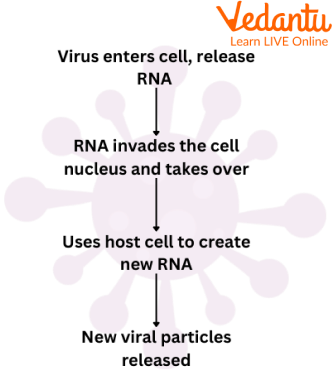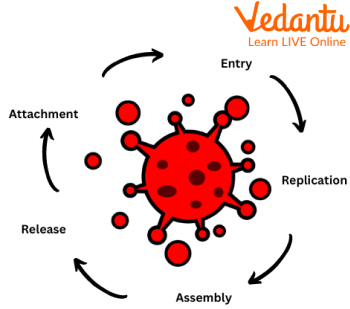




An Overview of Virus
A virus is a microscopic, contagious organism that can only grow inside living cells. Virus infections are possible in all living things, including plants, animals, and microorganisms like bacteria and archaea. Since Dmitri Ivanovsky's 1892 publication revealing a non-bacterial pathogen infecting tobacco plants and Martinus Beijerinck's 1898 discovery of the tobacco mosaic virus, more than 9,000 virus species of the millions of types of viruses in the environment have been documented in detail. The study of viruses is known as virology, which is a subfield of microbiology. This article has explained viruses in detail. The reproduction of viruses, and how they work, all of this has been discussed in the article given below. Let’s take a look.

Virus
How Viruses Work?
Viruses are both beneficial and harmful. The Bacteriophage virus is an advantageous virus that shields people against illness by eliminating the germs that cause conditions like cholera, dysentery, typhoid, etc. Some viruses cause disease in plants or animals and are harmful. HIV, influenza virus and poliovirus are the major diseases causing disease. Viruses are transmitted by contact, by air, by food and water, and by insects, but specific types of viruses are transmitted by specific methods. Outside of the cell, viruses are dead, but once inside, their life cycle begins.

Virus Work
Reproduction of Virus
Attachment, penetration, uncoating, replication, assembly, and release are the six phases of viral replication. During attachment and penetration, the virus attaches to a host cell and injects its genetic material there. A technique known as the lytic infection is used by lytic viruses to reproduce. A virus penetrates the host cell during lytic infection, replicates, and causes the cell to lyse or explode.

Virus Reproduction
How Viruses Reproduce
The only way a virus may reproduce is if it infects a host cell. A virus is a tiny, infectious particle. In essence, viruses "command" the host cell into becoming a virus factory by using its resources to create other viruses. Because they cannot reproduce on their own, viruses are not regarded as living organisms (without a host). Viruses rely on the protein synthesis pathways of their host cell to replicate because they are unable to do so on their own. This often occurs when a virus inserts its genetic material into host cells, uses the proteins to produce viral replicas, and multiplies until the cell explodes from the high number of additional viral particles.

Viruses Reproduce
Summary
To conclude all the conceptual understanding regarding viruses in this article, we can say that every living thing has viruses, which are biological agents. While some are safe, others can spread a variety of illnesses, from the common cold to Ebola. Obtaining protection from potentially harmful viruses, such as through vaccines, can aid in the prevention of life-threatening illnesses. We have discussed enough viruses in this article. We discussed the reproduction of viruses, and how they work in the above article. We hope you enjoyed reading this article, in case of any doubts, feel free to ask in the comments.
FAQs on How Viruses Work?
1. What are the features of viruses?
The characteristics of a virus influence how easily it can propagate.
Viruses can Spread Through:
Touch: For instance, if a person touches their eyes, nose, or mouth while carrying the SARS-CoV-2 virus on their hands, the virus may enter the body and cause COVID-19.
Respiratory Droplets: Respiratory droplets may contain some viruses. These come from speaking, coughing, or sneezing. Two examples of viruses that can do this are influenza and SARS-CoV-2.
Direct Contact: Some viruses can spread through close contact with an infected person. For instance, the human papillomavirus (HPV) can spread through skin-to-skin contact. The mononucleosis (mono)-causing Epstein-Barr virus can be transmitted through saliva, such as while kissing.
Bodily Fluids: For instance, the exchange of blood or sperm can transmit the HIV virus from one person to another.
Contaminated Food or Water: One kind of virus that can enter the body through contaminated food or water is the norovirus.
Insects: Mosquitoes transport the virus that causes Zika from one person to another.
Around Childbirth: An unborn child can contract the herpes virus cytomegalovirus from a mother who has it.
2. What if the virus changes?
Viruses often change over time. "Copying mistakes" and genetic alterations happen spontaneously as they replicate. Some of these changes are extremely tiny and might not raise concern, but others can be more important. They might also assist the virus in dodging the immune system or medicines already in use. For instance, to treat HIV, doctors combine various medications, making it more difficult for the virus to evolve treatment resistance. Known antigenic shift is a capability of influenza viruses. This may occur if a host cell has acquired two distinct influenza virus infections. A new influenza virus can be created by the two influenza viruses "reassorting." For instance, pigs are frequently used as a vessel for the mixing of human and avian influenza viruses.
3. What are the sources of Viruses?
Viruses are challenging to track across time since they do not leave behind fossilised traces. To compare the DNA and RNA of viruses and learn more about their origins, scientists use molecular tools. Three opposing hypotheses Trusted Source attempt to explain how viruses first appeared. In fact, any of these processes could have led to the evolution of viruses.
According to the regressive or reductionist concept, viruses originally existed as independent biological agents before evolving into parasites. They lost the genes that made them parasites over time and became completely reliant on the cells they were living in. According to the progressive or escape hypothesis, viruses originated from bits of DNA or RNA that "escaped" from the genes of larger organisms. According to the "virus-first" theory, complex nucleic acid and protein molecules initially gave rise to viruses billions of years ago, either before or at the same time as the earliest cells on Earth.









